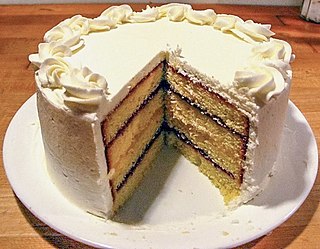
Cake is a flour confection made from flour, sugar, and other ingredients and is usually baked. In their oldest forms, cakes were modifications of bread, but cakes now cover a wide range of preparations that can be simple or elaborate and which share features with desserts such as pastries, meringues, custards, and pies.

Custard is a variety of culinary preparations based on sweetened milk, cheese, or cream cooked with egg or egg yolk to thicken it, and sometimes also flour, corn starch, or gelatin. Depending on the recipe, custard may vary in consistency from a thin pouring sauce to the thick pastry cream used to fill éclairs. The most common custards are used in custard desserts or dessert sauces and typically include sugar and vanilla; however, savory custards are also found, e.g., in quiche.
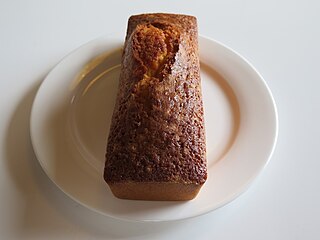
Pound cake is a type of cake traditionally made with a pound of each of four ingredients: flour, butter, eggs, and sugar. Pound cakes are generally baked in either a loaf pan or a Bundt mold. They are sometimes served either dusted with powdered sugar, lightly glazed, or with a coat of icing.
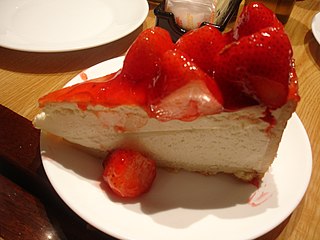
Cheesecake is a dessert made with a soft fresh cheese, eggs, and sugar. It may have a crust or base made from crushed cookies, graham crackers, pastry, or sometimes sponge cake. Cheesecake may be baked or unbaked, and is usually served chilled.
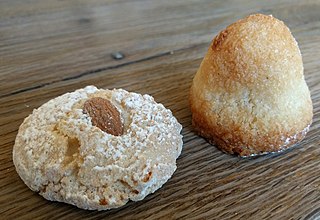
A macaroon is a small cake or cookie, originally made from ground almonds, egg whites, and sugar, but now often with coconut or other nuts. They may also include jam, chocolate, or other flavorings.

Rice pudding is a dish made from rice mixed with water or milk and commonly other ingredients such as sweeteners, spices, flavourings and sometimes eggs.
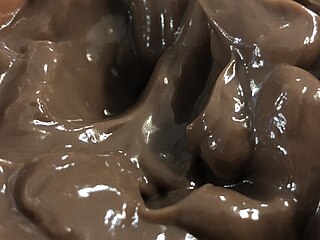
Chocolate puddings are a class of desserts in the pudding family with chocolate flavors. There are two main types: a boiled then chilled dessert, texturally a custard set with starch, commonly eaten in the U.S., Canada, Germany, Sweden, Poland, and East and South East Asia; and a steamed/baked version, texturally similar to cake, popular in the UK, Ireland, Australia, Germany and New Zealand.

Torta caprese is a flourless cake made with chocolate and either almonds or hazelnuts. Named for the Italian island of Capri, from which it originates, the cake is widely known and especially popular in nearby Naples, Italy.

Chocolate cake or chocolate gâteau is a cake flavored with melted chocolate, cocoa powder, or both. It can also have other ingredients such as fudge, vanilla creme, and other sweeteners.

A génoise, also known as Genoese cake or Genovese cake, is a French sponge cake named after the city of Genoa and associated with French cuisine. It was created by François Massialot in the late 17th century. Instead of using chemical leavening, air is suspended in the batter during mixing to provide volume.

Puto is a Filipino steamed rice cake, traditionally made from slightly fermented rice dough (galapong). It is eaten as is or as an accompaniment to a number of savoury dishes. Puto is also an umbrella term for various kinds of indigenous steamed cakes, including those made without rice. It is a sub-type of kakanin.

Flourless chocolate cake is a dense cake made from an aerated chocolate custard. The first documented form of the cake was seen in Ferrara, Italy, though some forms of the cake have myths surrounding their origins. The dessert contains no gluten, which makes it acceptable for those with celiac disease, gluten-free diets, and during religious holidays in which gluten and grains are not permitted.

Jumbles are simple butter cookies made with a basic recipe of flour, sugar, eggs, and butter. They can be flavored with vanilla, anise, caraway seed, or other flavoring like almond. They were formerly often made in the form of rings or rolls.

Sponge cake is a light cake made with eggs, flour and sugar, sometimes leavened with baking powder. Some sponge cakes do not contain egg yolks, like angel food cake, but most of them do. Sponge cakes, leavened with beaten eggs, originated during the Renaissance, possibly in Spain. The sponge cake is thought to be one of the first non-yeasted cakes, and the earliest attested sponge cake recipe in English is found in a book by the English poet Gervase Markham, The English Huswife, Containing the Inward and Outward Virtues Which Ought to Be in a Complete Woman (1615). Still, the cake was much more like a cracker: thin and crispy. Sponge cakes became the cake recognised today when bakers started using beaten eggs as a rising agent in the mid-18th century. The Victorian creation of baking powder by English food manufacturer Alfred Bird in 1843 allowed the addition of butter to the traditional sponge recipe, resulting in the creation of the Victoria sponge. Cakes are available in many flavours and have many recipes as well. Sponge cakes have become snack cakes via the Twinkie.

Hostess CupCake is an American brand of snack cake produced and distributed by Hostess Brands and currently owned by The J.M. Smucker Company. Its most common form is a chocolate cupcake with chocolate icing and vanilla creme filling, with seven distinctive white squiggles across the top. However, other flavors have been available at times. It has been claimed to be the first commercially produced cupcake and has become an iconic American brand.

Karpatka is a traditional Polish cream pie with some sort of vanilla buttercream filling – areated butter mixed with eggs beaten and steamed with sugar, areated butter mixed with crème pâtissière or just thick milk kissel enriched with melted butter. Professionally it is made of one sheet of short pastry covered with a layer of choux pastry with a thin layer of marmalade and a thick layer of cream in between. Nevertheless, the version with two layers of choux pastry is popular. The cake is cut into squares or rectangles and dusted with icing sugar.


























